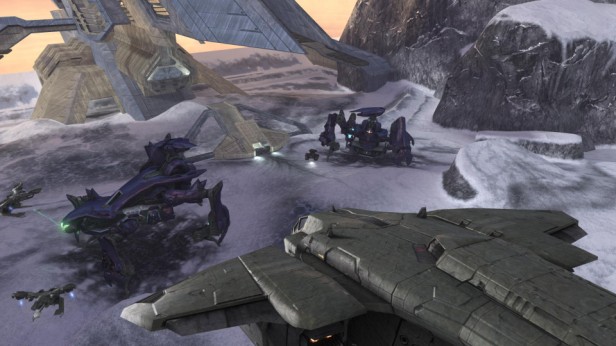
November 13, 2012
In
Uncategorized
Gaming Stories: Halo 3
We all have anecdotes about our games, and the power of single-player video games lies in the games’ ability to bind us with shared moments. If I know that you’ve also played Castlevania II: Simon’s Quest, I can reasonably assume that you too faced the disappointing final boss in an empty and anti-climactic mansion. It’s a common touchpoint, and communities are built on sharing our experiences.
So, from now until the end of the year, I’m going to try to share one of my gaming stories a day. The goal is not to recap the game’s events but to tell my story of that moment, almost like building my personal gaming memoir.
Since Halo 4 was released last week, let’s revisit my favorite moment from Halo 3, which I’ve titled “The Taking of Scarabs 1, 2, Boom.”
For as large the scope of the Halo series has been, it’s a surprisingly solitary experience. Humanity is losing an intergalactic war, but the chapter “The Covenant” in Halo 3 was the first time that I felt like I was a part of a great war. The fiction places the Master Chief as a monumental figure, the demon of death feared by humanity’s enemies, but he is usually a solitary operator in the field. The space battle taking place above Earth outside Cairo Station at the beginning of Halo 2 was nice to observe, but ships blowing up in the distance didn’t convey to me the feeling of being part of something grander. So, when cutscene that opened “The Covenant” showed seven dropships in formation ready to conduct a coordinated strike on enemy bases, I sensed that this chapter would be different.
Once the combat started, however, the game’s scope narrowed again. With our forces divided to hit the enemy in three simultaneous blows, I was alone to face the opposition in my tower. I remained alone even when I flew over to another tower to rectify the botched mission there.
Once the three towers were under friendly control, and I boarded a Scorpion tank in silence. As part of the metagame between the developers and the player, I knew that I would not have been given control of a tank unless I was going to face a challenge that required it. We moved from a vibrant and sunny shore through a tunnel to snowy mountains that were lit by a weak sun. The lonely piano at the beginning of “One Final Effort” is almost wistful, one set of notes repeating the other in a different octave, and I saw the snowy plain where the battle would take place. The strings have joined the piano, but I’ve lost a passenger on my Scorpion tank. The strings are have become more energetic, and I’m struggling to navigate the snowy cliffs in my unwieldy tank while fighting a combination of enemy Ghosts, Wraiths, Prowlers, and turrets.
“Hornets in-bound!”
Even the piano had picked up the pace by now to join the strings’ energy. A Scorpion tank and Hornets? Something wasn’t right. We used the Hornet earlier in the chapter to escort a dropship and engaged in dogfights against Banshees, but we’ve been on the ground since then. The passengers on my tank have all perished, and the tank itself is on fire.
“I count two Scarabs. Repeat, two Scarabs!”
Well, now I knew why the developers have given me all this firepower.
The air started swarming with Hornets and Banshees, joined by the pounding music. I had to choose how to solve this combat puzzle. We had taken out a Scarab in Halo 2 on foot and a Scarab earlier in Halo 3‘s chapter, “The Storm,” on a Mongoose. Should I use the Scorpion or the Gauss Warthog to knock the Scarab down so I can board it to destroy it? Should I just use the Scorpion’s cannon to fire directly on the Scarabs’ engines to trigger their destruction? I could, but enemy Ghosts scampered to and fro, almost vibrating in their enthusiasm to stop me. Should I use the Hornet to destroy the Scarabs from the air? I could, but enemy Banshees vied with friendly Hornets and a friendly Pelican dropship for air superiority.
I made my choice. I would take to the skies. I weaved in between enemy fire, and I was methodical in my assault. I destroyed the enemy Banshees. I wrecked the Scarabs’ main guns and bombarded the troops who dared to show themselves on the Scarabs’ decks. I stripped the Scarabs’ of their armor. And then I directed those rockets into the Scarabs’ engines to trigger their destruction. I had felt like the god of death and destruction that the Covenant’s Grunts ran in fear from before, but this was on a greater scale than ever before. The music swelled, the Scarabs’ engines finally went critical, and there was a satisfying “Boom.”
“Both Scarabs down. Well done.”
Thanks, Cortana. I like to take pride in my work.
“Kill the stragglers.”
Oh. That’s a bit bloodthirsty of you, but what’s a few aliens more? The music is positively triumphant, almost inspirational, as I did what Cortana asked.
“Calamity! If we only had more time.”
As I crossed the bridge to my next mission objective, the strings faded away to one sustained note, and the melancholy piano returned. I agreed with 343 Guilty Spark. That was the series’s finest moment, the perfect melding of music and player control in a combat puzzle, and this was the closest the Halo games came to matching the scope that it tried to present. This near perfect moment was all too brief, and replaying the section would be nothing more than chasing that high to diminishing returns. I secured that memory and moved on to slay some more aliens.

